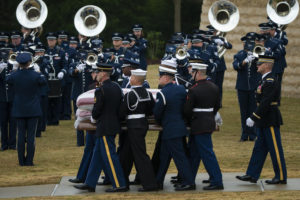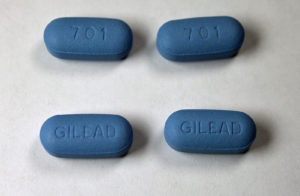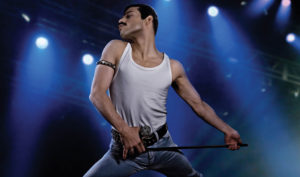How I Terrified Teenagers About AIDS in the 90s—and Why I Stopped
A HIV survivor and former instructor reflects on his experiences. HIV/AIDS fearmongering was encouraged by health departments during the 1990s. Image: An empty high school classroom via Adobe.
HIV/AIDS fearmongering was encouraged by health departments during the 1990s. Image: An empty high school classroom via Adobe.
This article was originally published by Filter, an online magazine covering drug use, drug policy and human rights through a harm reduction lens. Follow Filter on Facebook or Twitter, or sign up for its newsletter.
In the summer of 1992, a few weeks after I’d learned I had HIV, I was down at the local HIV task force office in Olympia, Washington. Someone from the health department asked me how old I was, and when I told him I was 18 he asked if I’d be interested in talking about my status to high school students. All I had to do was take a quick class about the basics of how HIV transmission worked, and then they’d pay $50 per speech.
Once the school year started up again that fall, the health department started sending me out to local high schools. There were four other speakers, but I was the only teenager. We weren’t given a script or told what to say, but we understood that our job was to scare people by saying that what happened to us could happen to them.
Public messaging around HIV transmission in the early 1990s was terrifying. Martin Scorsese was directing PSAs styled after slasher films like Nightmare on Elm Street. Spike Lee would narrate: “One night a year ago, Vanessa got high with some guy. She forgot everything that she learned about preventing AIDS. Now her life is the horror show. AIDS, another way that drugs can kill you.”
The fearmongering felt off to me, but at first I didn’t think about it too hard.
The first few gigs went more or less the same way. Someone from the health department would open with a scientific overview of HIV that made everyone’s eyes glaze over, then close by telling the students that anyone could get AIDS if they did risky things like have sex.
Next up was a man who looked to be in his early 30s. He’d describe what it had been like to watch his lover die, and how he regretted being promiscuous like so many other gay men his age. His emotion was real, but the kids in the audience didn’t usually connect with it.
I emasculated the guys and I slut-shamed the girls.
Then a former corrections officer would talk about how she’d quit her job because she didn’t want to risk getting her blood on someone if a fight broke out. The next person was her husband, a current corrections officer. The fourth speaker was a clean-cut middle-aged man who’d make it clear that he was not gay or promiscuous, and so if he had gotten the virus, anyone could get it.
I always went last. I’d start by saying I was from Port Angeles, not too far from here. Then I’d hone in on some smug-looking jock and tell him that, who knows, we might even have had sex with some of the same girls. I’d move on to someone else and tell them that if they ever ended up in juvie—a lot of those facilities were co-ed back then—they might want to think twice about who they hooked up with in there.
I did some variation of this each time. I was a jerk. I emasculated the guys and I slut-shamed the girls. Even when I talked about shooting up and made it sound a lot more rock and roll than it actually was in my daily life, the health department folks never stepped in because by the time I was done, those kids were good and scared.
I hated these kids. Scaring them in exchange for $50 worked fine for me.
The fearmongering always felt off to me, but at first I didn’t think about it too hard. Despite the health department’s enthusiasm about getting an actual teenager into the group, to me it was obvious that these students weren’t my peers; they were students. They all went to school and then they went to the houses they lived in with their families, or at least that’s how I pictured them. My high school experience spanned of a couple of months spread across two schools in the ninth grade. I didn’t have a home to go home to. I hated these kids. Scaring them in exchange for $50 worked fine for me.
At one school, a few minutes before I was supposed to head into the auditorium, I was smoking a cigarette outside the cafeteria a few feet from a group of students doing the same. I recognized them, not in the sense that I’d ever met them before but in that they, like me, were the outcasts. The lonely souls, the black sheep, the socially awkward. They were the group I’d have fit in with if I went to school there.
I told them why I was there. We kicked it for the rest of their lunch hour, until it was time for me go to the auditorium. They shook my hand and said they’d see me in there.
After the speech, I smoked another cigarette in the same place and saw the same group nearby, but they didn’t come over this time. As I was walking away, I looked back and saw them standing in a circle around the cigarette butt I’d flicked on the ground. One of them was gingerly poking it with a stick, trying to get it into a discarded Dixie cup.
That was when I realized why I’d never liked our messaging. I’d done what I was there to do, which was to scare the shit out of them, but I hadn’t really made them afraid of HIV; I’d made them afraid of me.
A lot of the educational messaging from that time focused on risks that weren’t really risks at all, or at least on a public-health scale. Oral transmission risk is extremely low. The virus doesn’t spread from contact with unbroken skin, and even if blood from someone living with HIV falls onto an open wound of someone else, transmission is rare.
In drug user communities, where I talked about HIV harm reduction every day for free, people didn’t react to me with fear.
At the next gig a week later, I dropped the aggressive approach I’d been taking before. I addressed the students earnestly. I showed them my track marks and, while the health department lady squirmed in her seat, talked about how I never went anywhere without sterile syringes so that everyone I shot up with would have one, too. I talked about how my girlfriend didn’t have HIV, and how we always used condoms but not for oral sex because there wasn’t really a risk of transmission that way. This, finally, was a bridge too far for the health department lady, who jumped in to make sure the students knew they should always use condoms.
I did another four or five of these before the health department stopped inviting me back. But it was enough for me to learn how peer education really worked and what it really meant.
In drug user communities, where I talked about HIV harm reduction every day for free, people didn’t react to me with fear. Of course, they actually related to me as a peer—they were shooting up with me—which was why those conversations happened naturally and gave them information they could actually use.
At two different schools, a couple of students caught me on the way out and asked if it was true I carried sterile syringes everywhere, and could they get a few so they didn’t have to share. At all of them, I told everyone how they could go down to their local health department and there’d be a fishbowl full of free condoms they could grab a handful and leave without having to talk to anyone, which no one from the actual health department had ever told them.
Your support matters…Independent journalism is under threat and overshadowed by heavily funded mainstream media.
You can help level the playing field. Become a member.
Your tax-deductible contribution keeps us digging beneath the headlines to give you thought-provoking, investigative reporting and analysis that unearths what's really happening- without compromise.
Give today to support our courageous, independent journalists.





You need to be a supporter to comment.
There are currently no responses to this article.
Be the first to respond.